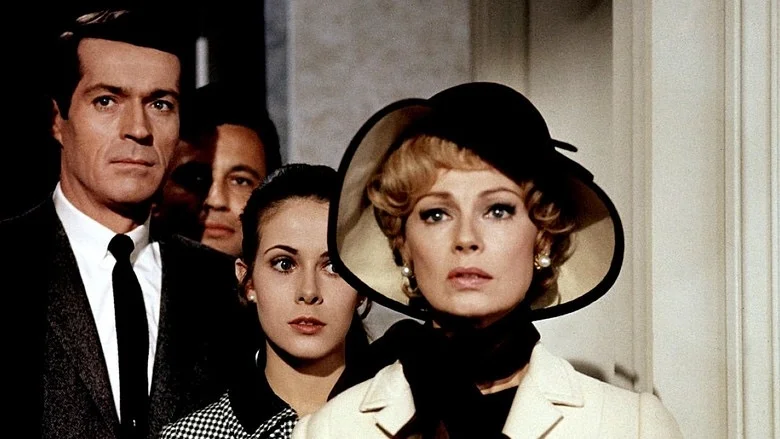Beginner's Guide to Alfred Hitchcock: Rope (1948)
In honor of Pride Month, I decided to take a look at one of Alfred Hitchcock’s lesser-known films: Rope. This film was the director’s first in color and first to star frequent collaborator James Stewart. Rope is notable for a few reasons: its one-take gimmick, the “perfect murder” premise, and its very explicit homosexual undertones. Hitchcock often looked at taboo gender and sexuality expressions in his films. Rebecca, Strangers on a Train, North by Northwest, and Psycho, among others, contain characters or subplots that were coded as sexually illicit for the time. Both Rope and Strangers on a Train are known as Hitchcock’s two “gay films,” bound together by their shared star Farley Granger and plots points that can easily be read as metaphors for male homosexuality.
Based on the 1929 play Rope by Patrick Hamilton, the film opens with the murder of David Kentley (Dick Hogan) by his two friends Brandon (John Dall) and Phillip (Granger). After murdering David by strangulation, Brandon and Phillip stuff the corpse into a trunk and prepare for a dinner party they are hosting later that night. Brandon has the macabre idea of serving dinner on the trunk for their guests — all of whom are friends and relatives of David. This includes Rupert Cadell (Stewart), who was once the housemaster of the three men back in prep school.
Both the play and the film are based on the real-life Leopold and Loeb murder case, though the real story is much more horrific. In the film, Brandon talks about Nietzsche’s theory of the Ubermensch. The two men learned this theory from Rupert but turned it into gruesome practice. Brandon and Phillip murder David as a display of their intellectual superiority over ordinary people and their dinner party is just an exercise for their egos. Brandon is shown to be the instigator to this perfect murder. As the film goes on, Phillip becomes hysterical and overwrought in contrast to Brandon’s calm and collected behavior.
The concept of the perfect murder is interesting and, true to Hitchcockian fashion, quite deliciously droll. Brandon gets a kick out of dropping subtle hints about David to his family and friends while manipulating his guests. Brandon invites David’s girlfriend Janet (Joan Chandler) with the hope of reuniting her with her ex-boyfriend Kenneth (Douglas Dick), also David’s best friend. Brandon has no real reason why except that he enjoys being a puppet master.
While it is never explicitly stated in the film, it’s quite clear that Hitchcock and screenwriter Arthur Laurents intended for Brandon and Phillip to be a homosexual couple. Their interactions with each other, especially when they are alone, suggest a sexual relationship between the two men. The murder has a sexual vibe, and the subsequent dialogue sounds post-coital. The actors give breathless, excitable performances—Brandon seemingly aroused; Phillip wracked with shame. The trunk with the man inside is like being “in the closet.” The girlfriend is looking for her missing boyfriend who’s actually in the trunk. Phillip can’t take the fear of being found out by society. Words like “gay,” “queer,” and “peculiar” are spoken often. Even the idea of two grown men of marriageable age living in an apartment together is strange. For the longest time, I swore that the apartment only had one bedroom. Characters only talk about “the bedroom.” I thought that was Hitchcock’s sly little joke to see if his audience was paying attention. But upon this rewatch I discovered I was wrong: the housekeeper Mrs. Wilson (Edith Evanson) says “the first bedroom.” The homosexuality in the film is hard to miss—though some critics have and probably did in 1948—once you think about it. The clues are there for those who can pick them up.
The filming of Rope is really fascinating, even for a single location dinner party thriller. Hitchcock wanted to experiment with this film and shoot it in one take. The camera magazines were ten minutes long, so Hitchcock staged about eight or nine cuts—some invisible, some rather not. This required the set to be mobile, so the walls in the apartment were on wheels to accommodate the camera. Hitchcock and cinematographer Joseph Valentine (who worked on Shadow of a Doubt) really emphasized the clutter of a dinner party, while also struggling with the lighting (especially the sunset). Rope is such a mesmerizing film because its technical achievements are striking for such a small movie. Hitchcock always knew where his characters were in the apartment, and his clear eye for suspense is on full display. There’s an especially exciting scene where Mrs. Wilson is clearing dishes off the trunk while all the guests are talking about David off-screen.
Rope is sort of a secret masterpiece for Hitchcock. I know many Hitchcock fans who call it their favorite for its deliberate direction and intelligent screenplay. The homosexual undertones add some subtext and history to the film. Part of the reason why it jumps out at me is that the actors both privately identified as gay or bisexual (according to most if not all accounts). Arthur Laurents too was gay. Even without that, however, the film works as a delightful, nail-biting ticker bomb thriller. I consider Rope to be Hitchcock’s most experimental film, even if it has that familiar Hitchcockian precision and elegance.
















